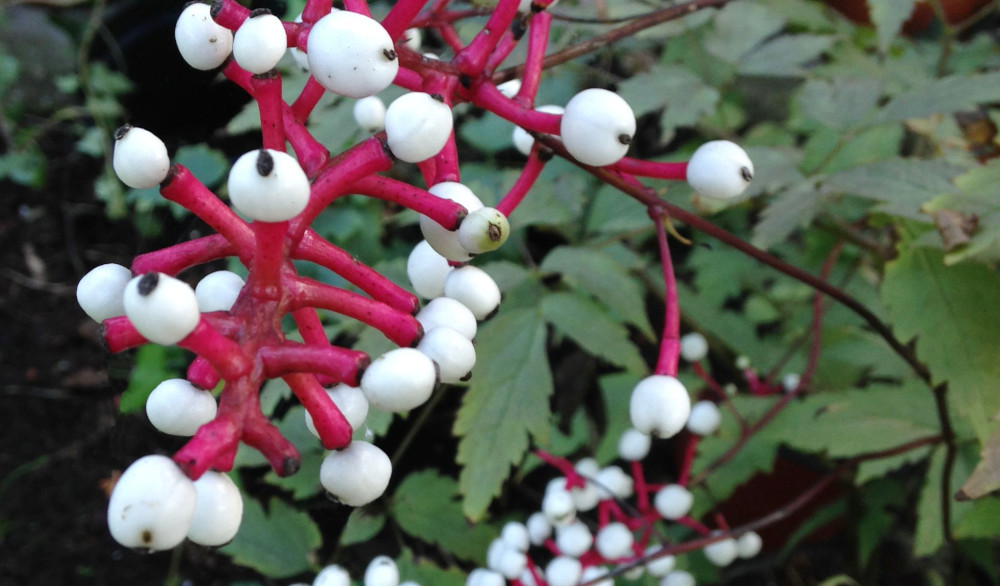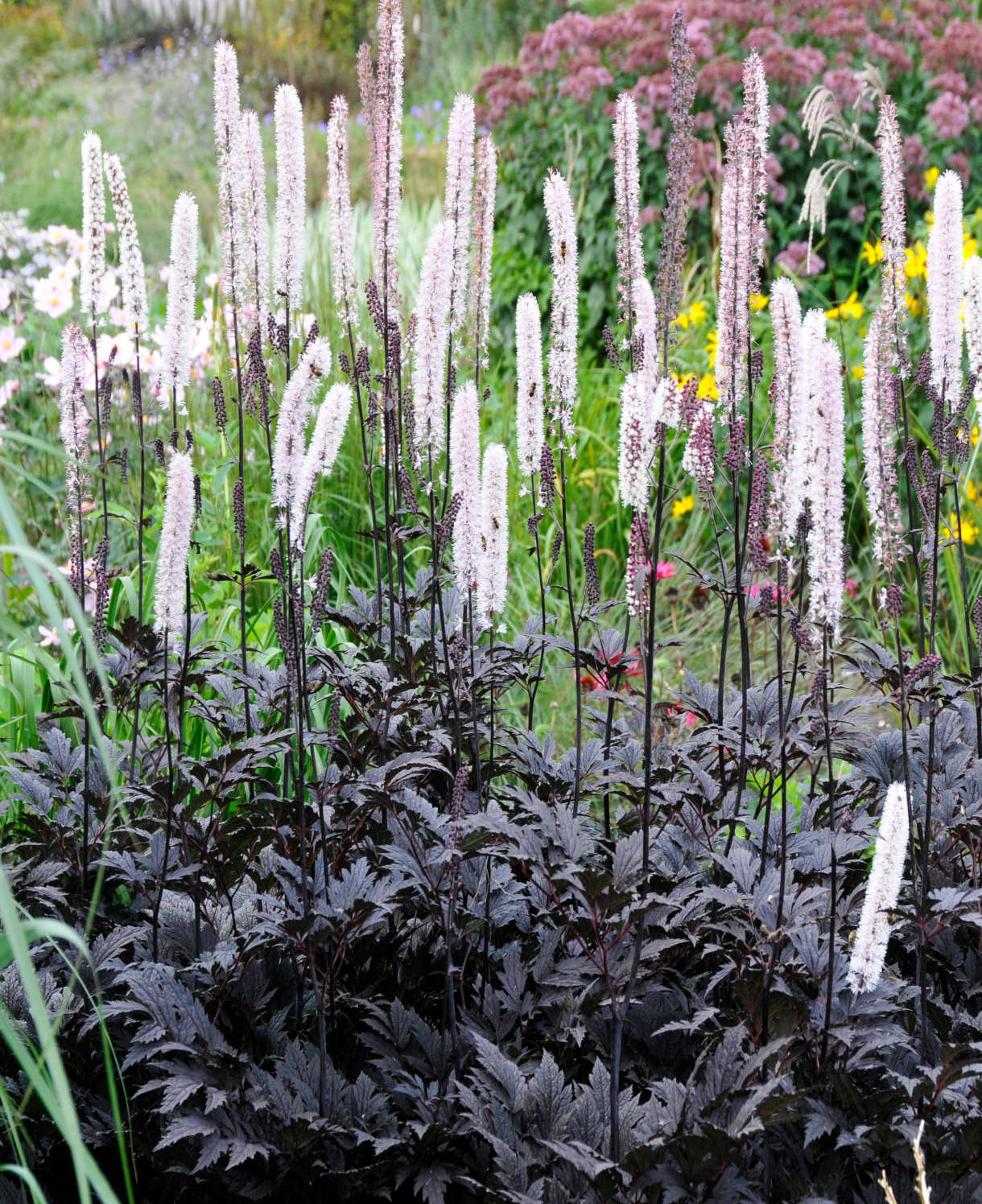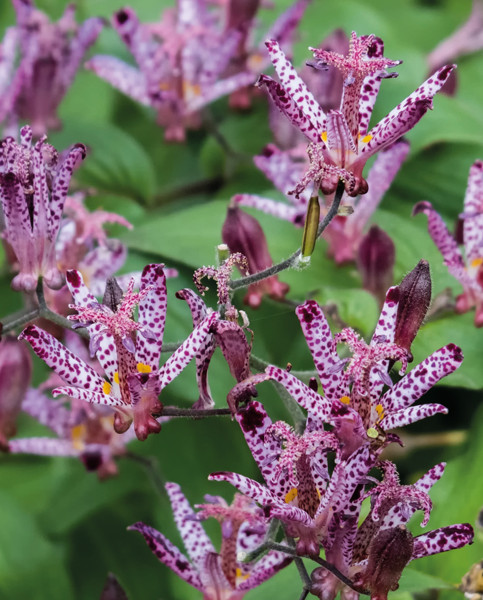How to grow Actaea
Also known as baneberries, these perennials originate from woodlands throughout temperate regions of the northern hemisphere. Grown for their architectural foliage, airy flower spires, bright, berry-like fruit, and ability to thrive in damp shade, actaea make a reliable and long-lived (up to 25 years) addition to the garden.
Clump-forming plants, actaea tend to have attractive, deeply divided basal leaves. A. racemosa and A. simplex are grown for their tall, lofty stems with spires of graceful white flowers held at the end. Resembling fuzzy, tapered candles, each spire is made up of many small, individual, star-like flowers. A. pachypoda has shorter stems with more oblong racemes of flowers, this species grown more for its berries. Held on stout, red stems, each berry is brilliant white with a black spot, bearing a strong resemblance to doll’s eyes (indeed this is one of the species’ common names).
Useful for brightening up shadier parts of the garden, actaea also provide a valuable source of nectar and pollen for insects.

Key Information
Soil pH
Position
Hardiness


Where & when to plant Actaea
For best results, plant in autumn or spring. An autumn planting is suitable for those gardening in ‘mild’ conditions. (Broadly speaking, this is the southern half of the UK). For those liable to very cold winters or waterlogged ground, it is best to wait until spring. (This is generally the northern half of the UK, or anyone gardening on heavy, clay soil).
Planting can be done at other times throughout the year providing a watchful approach to watering is taken until plants are established.
Actaea prefer cool, moist, partially shaded conditions with fertile soil (think of the woodland floors from which they originate). It is important to note that despite needing plenty of moisture, actaea dislike boggy conditions; ‘moist soil’ means consistently damp, yet with sufficient drainage to avoid becoming waterlogged.
How to plant Actaea
-
Clear the area of weeds
Dig an extra deep planting hole and add well-rotted organic matter (to increase moisture retention during drier months)
Place the plant in the hole
Backfill with soil and gently firm in with foot
Soak well with water
Mulch around the base with well-rotted organic matter
-
Continue to water well until fully established

What to plant with Actaea
Actaea go beautifully with other woodland favourites such as tiarella, Japanese anemone, tricyrtis and ferns. All have similar requirements for successful growth.
If you would like any further planting ideas or growing advice for your actaea, please contact our friendly and knowledgeable Customer Care Team - who will be more than happy to help you.



How to care for Actaea
Pruning and Deadheading
Cut the plant back to just above ground level each autumn.
Deadhead spent flowers throughout the flowering season to encourage more blooms. Alternatively leave on plant to develop attractive seed heads.
Watering
Water this moisture-loving plant well until established, then in very dry periods as required. The foliage of actaea tends to appear scorched if the soil is allowed to dry out.
Cold Protection
All actaea are fully hardy, requiring no cold protection.
Pests and Diseases
Actaea are generally trouble free, and in fact are known for being resistant to slug and snail damage (a valuable quality for a plant used in damp shade).
How to propagate Actaea
The quickest and easiest approach to propagating actaea is to lift and divide established clumps in early spring. As well as providing new plants, this is also useful in maintaining the health and vigour of existing specimens.
- Choose a day when the soil is not frozen or waterlogged
- Dig the plant out of the ground
- Shake off any excess soil
- Separate the plant into sections using either swift, cutting blows with a sharp spade, or two forks inserted back-to-back with tines touching, handles then pushed together to prise the plant apart
- Discard old, damaged or surplus pieces, keeping healthy, vigorous material
- Replant or pot up selected pieces as required
- Water well until fully established
Common Actaea Questions
Why are my flowers curved, when I have seen the same plant elsewhere with straight, upright flowers?
This is a reaction to light levels. Actaea planted in significant shade will tend to have flowers which bend gently towards the light. In full sun, they have more of an upright habit.
I have seen the same plant advertised as Cimicifuga. Which name is correct?
Both Actaea racemosa and Actaea simplex were formerly within the Cimicifuga genus. In 2000, they underwent a taxonomic revision by botanists, after genetic and morphological analysis found they more closely matched actaea. Changes such as this can take a generation or two to fully catch on, and so it is likely you will see the plants referred to by both names for some time.
Can I eat the fruits of actaea?
No, these fruits are highly toxic if ingested.
Will my actaea require staking?
Given an adequately sheltered spot, actaea is unlikely to need staking. If, however, the tall flower spires are regularly exposed to strong winds they may fall over without support.
Why is my actaea not flowering?
Actaeas can take time to establish, it is common for them to require a year or two of settling in before they flower. This will go for newly planted divisions as well. Once they have ‘settled’, these long-lived perennials will reward your patience with many years of flowering to come.




